

First Person Point of View — The Writer’s Craft. When you tell a story through a viewpoint character using I or we, you are using first person point of view.
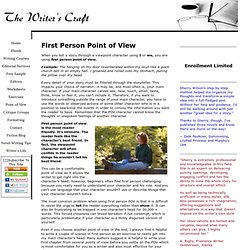
Example: The banging on my door reverberated within my skull like a giant church bell in an empty hall. I groaned and rolled onto my stomach, pulling the pillow over my head. Every detail of your story must be filtered through the storyteller. This impacts your choice of narrator—it may be, and most often is, your main character. If your main character cannot see, hear, touch, smell, taste, think, know or feel it, you can’t include it. First person point of view is the most reader friendly. This can be a comfortable point of view as it allows the writer to get right into the character’s head; however, beginners often find first person challenging because you really need to understand your character and his role. The most common problem when using first person POV is that it is difficult to resist the urge to tell the reader everything rather than show it. Considerations: How To Write A Novel Using The Snowflake Method.
Writing a novel is easy.
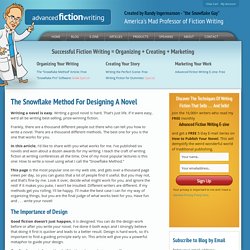
A Simple Novel Outline – 9 questions for 25 chapters « H.E. Roulo. Just as every tree is different but still recognizably a tree, every story is different but contains elements that make it a story.

By defining those before you begin you clarify the scope of your work, identify your themes, and create the story you meant to write. At Norwescon 2011 I sat in on a session called Outline Your Novel in 90-minutes led by Mark Teppo. c0043312.cdn.cloudfiles.rackspacecloud.com/iwl/short_story_writing.pdf. What Do You Do When Your Novel Goes Off Course? Story And Plot. Michael Arndt on setting a story in motion Michael Arndt explains some of the things he learned while working on the screenplay for Toy Story 3.
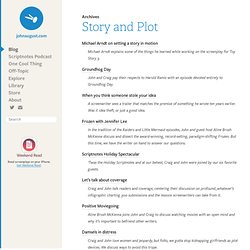
Groundhog Day John and Craig pay their respects to Harold Ramis with an episode devoted entirely to Groundhog Day. When you think someone stole your idea A screenwriter sees a trailer that matches the premise of something he wrote ten years earlier. Frozen with Jennifer Lee In the tradition of the Raiders and Little Mermaid episodes, John and guest host Aline Brosh McKenna discuss and dissect the award-winning, record-setting, paradigm-shifting Frozen.
Scriptnotes Holiday Spectacular ‘Twas the Holiday Scriptnotes and at our behest, Craig and John were joined by our six favorite guests. Let’s talk about coverage Craig and John talk readers and coverage, centering their discussion on profound_whatever’s infographic charting 300 submissions and the lessons screenwriters can take from it. Positive Moviegoing Damsels in distress Let me give you some advice. Tension. Hook Your Readers With Tension By Laura Backes, Write4Kids.com Tension.

Without it, life would be—let's face it—boring. So would fiction. Tension works with conflict to raise the emotional level of the text to a boiling point. It forces the reader to become invested in the story. How to Write Good Dialogue. Writing The Perfect Scene. Having trouble making the scenes in your novel work their magic?
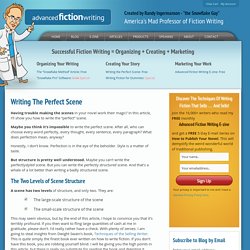
In this article, I’ll show you how to write the “perfect” scene. Maybe you think it’s impossible to write the perfect scene. After all, who can choose every word perfectly, every thought, every sentence, every paragraph? What does perfection mean, anyway? Honestly, I don’t know. But structure is pretty well understood. The Two Levels of Scene Structure A scene has two levels of structure, and only two. The large-scale structure of the sceneThe small-scale structure of the scene. How to Write a Horror Story: 12 steps. Adjunct Assistant Professor of English This article was co-authored by Christopher Taylor, PhD.
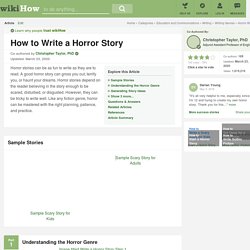
Christopher Taylor is an Adjunct Assistant Professor of English at Austin Community College in Texas. He received his PhD in English Literature and Medieval Studies from the University of Texas at Austin in 2014. Co-authors: 169 Updated: March 23, 2020 Views: 1,019,210. Www.archetypewriting.com/resources/downloads/bodylanguagecheatsheet.pdf. How to Write a Novel Using the Snowflake Method. Writing Realistic Injuries. Quick Contents Introduction General remarks What's normal?

Reactions to injury - including emotional reactions, fainting and shock. Minor injuries - such as bruises, grazes and sprains Head injuries - from black eyes to severe concussions Broken bones Dislocated jointsCutting and Piercing - for various locations, including blood loss symptoms and figures. Blunt trauma - getting hit, internal injuries.Burns - including electrical burns Hostile environments - such as extreme cold and heat, oxygen deprivation and exposure to vacuum.
References - useful websites. Introduction Characters climbing cliffs with broken arms or getting knocked out for an hour or so and then running around like nothing happened, bug me. Back to Quick Contents General Remarks There’s a lot of ‘relatively’ and ‘probably’ in this article because everyone reacts differently to injury. What’s Normal…? For a normal, reasonably healthy adult the following reading are ‘normal’.